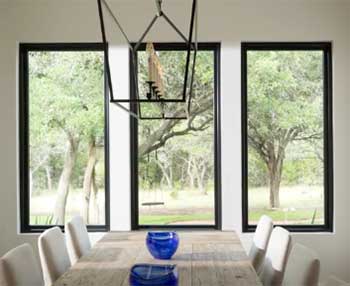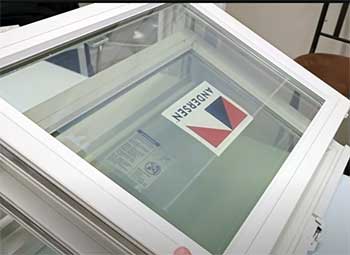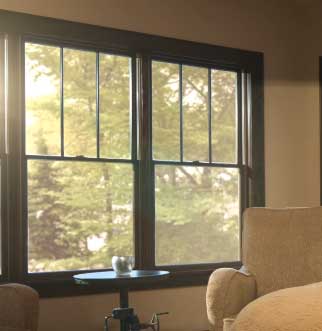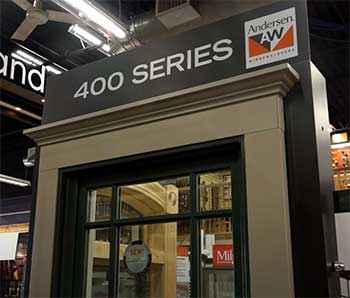I’ve always believed windows are the eyes of a home, letting in light and framing the world outside. When I set out to replace the windows in my 20-year-old house, I turned to Andersen, a brand synonymous with quality and innovation.
My mission?
To understand the differences between Andersen’s 100, 200, and 400 Series windows, weighing their pros and cons to find the perfect fit for my home.
In this article, I’ll share my insights to help you choose the right windows for your space, balancing style, durability, and budget.
A Brief Comparison Table
| Feature | 100 Series | 200 Series | 400 Series |
| Material | Fibrex composite | Wood interior, vinyl exterior | Wood interior, vinyl exterior |
| Window Types | Single-hung, casement, awning, gliding, picture | Double-hung, gliding, picture | Double-hung, casement, awning, gliding, picture, bay, bow, specialty |
| Exterior Colors | 6 (e.g., White, Black, Cocoa Bean) | 2 (White, Sandtone) | 7 (e.g., White, Black, Forest Green) |
| Interior Colors | 4 (e.g., White, Black) | 2 (Pine, White) | 4 (Pine, White, Oak, Maple) |
| Customization | Limited | Moderate | Extensive |
| Energy Efficiency | High (Fibrex insulation) | Good (wood insulation) | Superior (Perma-Shield exterior) |
| Price Range (per window) | $200–$300 | $300–$400 | $400–$600 |
| Durability | Excellent (20–30 years) | Good (15–25 years) | Excellent (20–30 years) |
| Maintenance | Low | Low | Low |
| Warranty | 20-year glass, 10-year non-glass | 20-year glass, 10-year non-glass | 20-year glass, 10-year non-glass |
My Journey Into Andersen’s Window World
When I started this project, I was overwhelmed by the sheer variety of windows out there. Andersen’s reputation for craftsmanship caught my attention, but their three main series—100, 200, and 400—left me scratching my head.
What made them different?
Which one would give me the best bang for my buck? I wanted windows that looked great, saved energy, and didn’t break the bank.
So, I rolled up my sleeves and dug into the details, visiting showrooms, talking to contractors, and even chatting with neighbors who’d gone through the same process. Here’s what I learned about each series, broken down into their key features, pros, and cons.
Andersen 100 Series: The Budget-Friendly Powerhouse

The 100 Series was the first to catch my eye because of its affordability.
These windows are made from Fibrex, Andersen’s proprietary composite material that’s 40% reclaimed wood fiber and 60% thermoplastic polymer.
I was intrigued by Fibrex—it’s twice as strong as vinyl, resists rot, and doesn’t need painting.
My home in New England faces harsh winters, so durability was a big deal for me.
Key Features of The 100 Series
- Material: Fibrex composite, which is eco-friendly and doesn’t flake, peel, or fade.
- Window Types: Single-hung, casement, awning, gliding, and picture windows. I noted that double-hung options are available in some markets, with a nationwide rollout expected soon.
- Color Options: Six exterior colors (White, Black, Cocoa Bean, Dark Bronze, Sandtone, Terratone) and four interior colors (White, Black, Cocoa Bean, Dark Bronze).
- Energy Efficiency: Fibrex provides excellent thermal insulation, reducing heat transfer 700 times better than aluminum.
- Price: Around $200–$300 per window, making it the most affordable of the three.
Pros of The 100 Series
I loved how low-maintenance these windows are. A quick wash once a year keeps them looking brand new. The Fibrex material impressed me with its strength—twice that of vinyl—and its resistance to warping or cracking, even in extreme weather.
Since I’m conscious about the environment, I appreciated that Fibrex uses reclaimed materials, reducing waste and volatile organic compound (VOC) emissions.
The energy efficiency was a big win, too; my heating bills in winter are a constant concern, and the 100 Series’ insulation properties promised savings. Plus, at $200–$300 per window, they fit my budget without sacrificing quality.
Cons of The 100 Series
However, the 100 Series isn’t perfect. The customization options are limited compared to the other series. With only six exterior and four interior colors, I felt a bit boxed in, especially since I wanted a specific shade to match my home’s exterior.
The window styles are also restricted—single-hung dominates, and if you’re set on double-hung or specialty shapes, you might be out of luck in some markets. I also noticed the frames are slightly wider than the 400 Series, which could make them look bulkier on traditional homes.
One contractor I spoke to even warned against using them for certain architectural styles, citing their “bug-eyed” appearance due to the glass sitting closer to the exterior trim.
Andersen 200 Series: The Middle Ground

Next, I explored the 200 Series, which seemed like a step up in terms of aesthetics but still budget-conscious.
These windows combine a wood interior with a vinyl exterior, offering a classic look with modern durability.
I was drawn to the idea of wood inside my home, giving it a warm, natural feel, but I wondered if the limited options would meet my needs.
Key Features of the 200 Series
- Material: Pine wood interior with a vinyl exterior, protected by Andersen’s Perma-Shield coating for weather resistance.
- Window Types: Double-hung, gliding, and picture windows, available in standard sizes only.
- Color Options: Two exterior colors (White, Sandtone) and two interior finishes (Pine, White).
- Energy Efficiency: Good insulation from the wood core, though not as advanced as Fibrex.
- Price: Roughly $300–$400 per window, a middle-tier option.
Pros of The 200 Series
The 200 Series struck me as a solid compromise. The wood interior added a touch of elegance to my living room, and the vinyl exterior meant I wouldn’t be repainting every few years. The Perma-Shield coating, introduced by Andersen in 1966, protects the wood from moisture, so I wouldn’t have to worry about rot or warping.
I also liked that these windows are Energy Star certified, which meant decent energy savings. For someone like me, who wanted a balance of cost and quality, the 200 Series felt like a reliable choice, especially for standard-sized openings in my home.
Cons of The 200 Series
But the 200 Series has its drawbacks. The customization options are slim—only two exterior colors and two interior finishes. I wanted a darker exterior to match my home’s trim, but Sandtone and White didn’t cut it.
The lack of custom sizing was another issue; my home has a few odd-shaped windows, and the 200 Series’ standard sizes wouldn’t work for those. I also learned that while the wood interior is beautiful, it’s more susceptible to moisture damage if not maintained properly.
The energy efficiency, while good, didn’t match the 100 Series’ Fibrex or the 400 Series’ advanced features, which made me question its value for the price.
Andersen 400 Series: The Premium Choice

Finally, I turned to the 400 Series, Andersen’s flagship line for homeowners who want it all—style, durability, and customization.
These windows also feature a wood interior with a vinyl exterior, but they take everything up a notch with more options and superior performance.
I was excited but hesitant, knowing the price tag would be higher.
Key Features of The 400 Series
- Material: Wood interior (pine, oak, or maple) with a vinyl exterior, enhanced by Perma-Shield for weather resistance.
- Window Types: Double-hung, casement, awning, gliding, picture, bay, bow, and specialty shapes, available in custom sizes.
- Color Options: Seven exterior colors (White, Sandtone, Terratone, Forest Green, Canvas, Dark Bronze, Black) and four interior options (Pine, White, Oak, Maple).
- Energy Efficiency: Superior insulation with Perma-Shield and multiple glass options for enhanced performance.
- Price: Approximately $400–$600 per window, reflecting the premium features.
Pros of The 400 Series
The 400 Series blew me away with its versatility. With seven exterior colors and four interior finishes, I could match my home’s aesthetic perfectly. The ability to order custom sizes in 1/8-inch increments was a game-changer for my oddly shaped windows.
The energy efficiency stood out, too; the Perma-Shield exterior and advanced glass options promised significant savings on my utility bills.
I was particularly impressed by the casement windows, where the entire sash is wrapped in vinyl, protecting it from rain even when left open. The 400 Series also felt like a long-term investment, with a lifespan of 20–30 years and a transferable warranty if I ever sell my home.
Cons of The 400 Series
The biggest downside? The cost. At $400–$600 per window, the 400 Series was a stretch for my budget, especially for a whole-house replacement. While the customization is fantastic, it can be overwhelming—choosing hardware, grilles, and glass options felt like a part-time job.
I also noticed that the compression jamb liner, while improving performance, isn’t the most attractive feature, especially if you opt for a two-tone window. For some, the premium price might not justify the upgrades over the 200 Series, especially if customization isn’t a priority.
Key Differences of Andersen Windows 100 And 200 And 400 Series

As I compared the three series, I realized each serves a distinct purpose.
The 100 Series is the practical choice for budget-conscious homeowners who value durability and energy efficiency.
Its Fibrex material is a standout, offering vinyl-like maintenance with twice the strength.
However, its limited customization and bulkier frames might not suit everyone, especially for traditional or custom homes.
The 200 Series is the middle child, offering a classic wood look at a reasonable price. It’s great for standard projects but falls short on flexibility.
If you’re okay with White or Sandtone exteriors and don’t need custom sizes, it’s a solid pick. Still, I found its energy efficiency and customization lacking compared to the others.
The 400 Series is the gold standard, with unmatched versatility and performance. It’s ideal for high-end homes or those seeking a specific aesthetic. The custom sizing and extensive color options made it tempting, but the price gave me pause.
I had to ask myself: was the premium worth it for my needs?
My Decision-Making Process

To choose, I considered my priorities: durability, energy efficiency, aesthetics, and budget.
Living in New England, where winters are brutal, energy efficiency was non-negotiable.
I also wanted windows that complemented my colonial-style home without requiring constant upkeep.
After visiting an Andersen dealer, I got hands-on with the windows.
The 100 Series felt sturdy but plain, the 200 Series had a nice wood warmth but limited colors, and the 400 Series felt like luxury—sleek, customizable, and robust.
I also thought about long-term value. The 100 Series’ Fibrex promised 20–30 years of durability, matching the 400 Series, while the 200 Series might need more care to reach that lifespan.
Energy savings were a factor, too; the 400 Series’ advanced glass options could shave more off my bills than the 100 or 200 Series. But with 25 windows to replace, the cost difference was significant—$5,000–$7,500 for the 100 Series versus $10,000–$15,000 for the 400 Series.
In the end, I mixed and matched. I chose the 400 Series for my main living areas, where aesthetics and custom sizes mattered most, and the 100 Series for less visible spots like the basement and bathrooms, where budget and durability were key.
This hybrid approach saved me money while giving my home the look and performance I wanted.
Tips For Choosing Your Andersen Windows
If you’re on the same journey, here’s what I learned to help you decide:
- Assess Your Budget: Be honest about what you can afford. The 100 Series is great for tight budgets, while the 400 Series is a splurge for premium features.
- Consider Your Climate: In extreme weather, the 100 Series’ Fibrex or the 400 Series’ Perma-Shield excels. The 200 Series is fine for milder climates but needs more maintenance.
- Think About Aesthetics: If your home’s style is specific, the 400 Series’ customization is worth it. For simpler needs, the 200 or 100 Series might suffice.
- Check Window Types: Ensure the series offers the styles you need. The 400 Series has the most options, while the 100 and 200 are more limited.
- Visit a Showroom: Seeing and touching the windows helped me understand their quality and appearance. It’s worth the trip.
Frequently Asked Questions (FAQ)
What is the difference between 200 Series and 400 Series?
The 200 Series has a wood interior with a vinyl exterior, two color options, and standard sizes, making it more affordable. The 400 Series offers the same materials but with seven exterior colors, four interior finishes, custom sizes, and superior energy efficiency, justifying its higher price.
Are Andersen 200 Series windows good?
Yes, they’re a solid choice for budget-conscious homeowners wanting a wood look with low maintenance. They’re durable and energy-efficient but lack the customization and advanced features of the 400 Series.
How much is Andersen 400 vs. 100?
The 100 Series costs $200–$300 per window, while the 400 Series ranges from $400–$600. The price difference reflects the 400 Series’ customization, additional styles, and enhanced energy efficiency.
Are Andersen 400 worth it?
For homes needing custom sizes, specific aesthetics, or top-tier energy efficiency, the 400 Series is worth the investment. If budget is tight or customization isn’t needed, the 100 or 200 Series may be sufficient.
Conclusion: Your Window, Your Choice
Choosing between Andersen’s 100, 200, and 400 Series windows is about aligning your needs with your budget and style. I found that the 100 Series offers unbeatable value and durability, the 200 Series balances cost and aesthetics, and the 400 Series delivers premium performance and customization.
You can’t go wrong with any of them, but it’s about what fits your home and lifestyle. Take your time, visit a showroom, and weigh the pros and cons. Your perfect windows are out there, ready to frame your view of the world.
